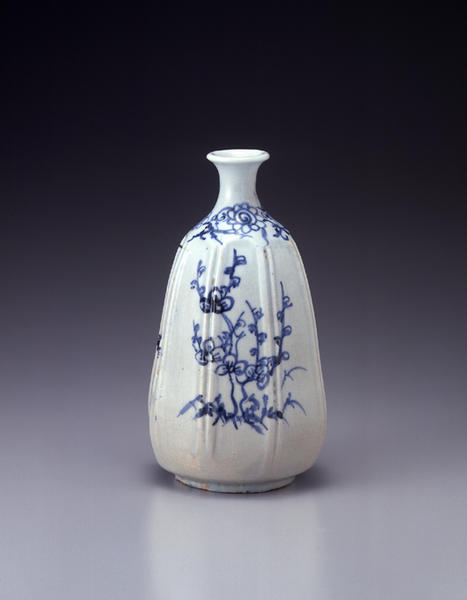伊万里染付四君子文徳利
- 佐賀県・有田窯
- 江戸時代
- 17c
- 呉須染付磁製
- H-20.6 D-12
豊臣秀吉による文禄・慶長の役(丁酉倭乱)で日本に連れてこられ朝鮮の陶工・李参平(りさんぺい)が有田町泉山(いずみやま)に白磁鉱脈を発見し、元和二年(1616)に白磁の焼成に成功したといわれている。これが日本で初めて焼かれた磁器とされている。初期の作品は中国古染付の影響を受けつつも、技術的には未熟であるため完全な磁器には至らなかった。しかしそれが逆に独特の釉調を示す結果となり、特に初期伊万里(古伊万里)と呼ばれて後世茶人の間で賞玩された。この徳利はいわゆる四君子といわれる梅、竹、蘭、菊が呉須で描かれ、縦に二筋の畝が施された面取状の器胎となっている。釉調はややかたいものの、伸び伸びと描かれた染付は初期の様相を呈している。
伊万里焼(いまり)
佐賀県有田町で焼かれた磁器。隣接する伊万里港から製品のほとんどが出荷されたため当初からこう呼ばれました。唐津同様、豊臣秀吉による文禄・慶長の役(丁酉倭乱)で日本に連れてこられた朝鮮の陶工・李参平(りさんぺい)が有田町泉山(いずみやま)に白磁鉱脈を発見し、元和二年(1616)に白磁の焼成に成功したといわれています。中国古染付の影響を受けた初期の作品は特に初期伊万里(古伊万里)と呼ばれます。
伊万里染付鷺樹木文壺
伊万里染付草花文大皿
Catalogue Entry
Two relatively thickly drawn overlapping lines circle the torso of this Imari ware sake bottle. Similarly free, flying brushstrokes were used to depict the so‐called “Four Gentlemen" motif on the shoulders and torso of the bottle. Shards of this type of ware have been excavated from the Hizen Hyakken kiln (present‐day Yamauchi‐cho, Kishima‐gun, Saga prefecture). The so‐called “four gentlemen flowers" are plum, chrysanthemum, orchid, and bamboo. Among all plants and flowers, these four are considered to be lofty in character, and hence have been likened to the loftiness of gentlemen. They are a popular theme in East Asian painting. This jar was fired at a high temperature, and its resulting slight tilt is immediately appealing, while the flowers and plants drawn in vivid, high quality cobalt pigments combine with the lovely white porcelain body clay to create an elegant wine bottle.
